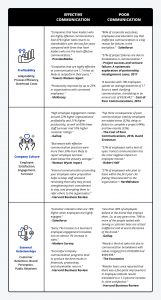Business is all about competition. Today, the big player in that competition is customer experience.
A survey by Harris Interactive found that a quarter of U.S. adults don’t feel loyalty toward any type of brand. And, 56% of those surveyed said they’d be at least somewhat likely to switch brands based on new customer service options.
That’s significant – it means people now decide to do business with you (or not) because of your customer service. And without a high-performing call center, it’s difficult to deliver the standout service customers have come to expect.
Customers today want to be wooed. They place value on the quality you offer them, both through your product or service and through your customer interactions. And now, as many as 86% of U.S. adults expect brands to offer multiple channels and flexible timing to interact with customer service agents.
How do you keep up?
Your First Line of Defense
Who is your first line of defense when you think of your company’s retention of a customer? Your call center agents.
Day-to-day your agents handle your most pressing customer issues and learn the ins-and-outs of your business. Think of all the data your agents collect through their conversations with customers. Now, imagine all they can do with it when given the right reporting tools and better access to that data.
When you deploy a call center with the right tools, your customer service agents are your greatest resource. Modern contact center agents are almost like user experience researchers for your company. They learn about your customers and store all the information so it’s usable by their peers and leaders. Then, they apply it to make the customer service experience better.
To support your agents on this mission, you have to know how to deploy a call center system that works for your agents (not against them).
Sure, there are many ways to offer support. Good management, proper training and coaching, employee engagement strategies, the list goes on. But, adopting the right tools in a call center can motivate your agents to provide better service and improve loyalty.
What’s next? Adding new tech to your call center can get messy without a plan in place. Let’s look at some necessary steps on how to deploy a call center system for a better CX.
1. Gather Feedback for the Best Experience for Everyone
Get your Agent’s Perspective
Deploying new call center software impacts every process your team has. It requires full support from your agents to work most effectively.
What good is new technology if your employees don’t like it or find it hard to use? If it doesn’t help resolve the issues your customers experience, what’s the point?
Before you even begin looking at vendors, you need a wish list. Start with your own perspective: Where are the gaps in your contact center that the right software could fill? As a manager, what tools would relieve you of the most stress? Or, what could take the most off your plate? What are some of the reporting or data needs you need to fill?
Then, invite your agents into the mix. Through team meetings, 1:1s, or surveys, gather feedback from your employees. Ask them what would help them be more efficient and effective in their roles.
Do they feel overwhelmed by the number of duplicate requests they get daily? Maybe they long for a way to get immediate feedback on their interactions so they can gauge how they’re performing. Or, do you have too many different software platforms? Maybe you’ve heard agents request a platform that has everything they need, all in one place. So, they don’t need to jump from window to window to access customer information, record data, or get product information.
Get your Customer’s Perspective
Lastly, you’ll need to know what your customers need to get the right software to support them. What channels are your customers using? What knowledge do you need from them and where will it be stored safely? Perhaps your customers could benefit from more self-service tools and a better IVR to answer their basic questions.
The technology you use will play a fundamental role in how you deliver service and prosper internally. You want to make sure that you gather the needs and feedback of those who have to use the software daily before diving into vendor research. Start with an inside-out, then an outside-in, approach to help you make informed choices that are relevant to your team’s goals. Include both your agents and customers into this stage for a more successful implementation of the software.
2. Choose the Right Vendor
Whether through an RFP or extensive research, your management team will need to find the right software vendor to partner with. Use your wish list as a starting point and work with your finance team to understand budget limitations. Vendor selection is tricky business. Include your IT team and any software engineers you may have on staff in the decision process to know you’re covering all your bases.
Then consider the following questions to narrow your search:
- What vendors do your competitors use?
- Which vendors have strong reputations in the industry and why?
- What features do they have and which are they looking to add/improve with time?
- Does the vendor offer tiered pricing and feature packages? In other words, how scalable is the product?
- How secure is the software and who owns what data?
- Will the vendor treat me like a partner, or like a number?
Once you’ve narrowed the vendor list, you should consider what support they provide you. Do you have an individual point of contact with the company that you can trust to support your use of their product? Do you have an assigned project manager to guide you through the customization of your software?
Of course, you can’t just throw the new technology at your team and expect them to pick it up. So, how will your vendor provide continued learning resources and training? How well does your vendor know their own technology? Do they send someone onsite to train you and your agents or does the burden of training fall on you?
Then with some of these questions answered, demos watched, and sales pitched, your team will have a better idea of their options. Then, you can deliberate and choose which product you’ll adopt.
3. Create Processes for Successful Deployment
Call centers need more than phones, computers, and people. Successful call centers run smoothly only with established processes to follow. Using your vision for your team come up with the processes that will make the deployment of your new software most efficient and valuable.
When you pair your new software with the right processes, you can reach new heights, solve issues faster, and have happier customers.
Consider what questions your call center processes need to answer with your new software:
- How will you assign incoming interactions if they come through different channels?
- What KPIs are a priority in tracking for quality assurance?
- How will you integrate your CRM to track customer history?
- How will your agents document each customer interaction?
- Will calls be recorded?
- How will you use training and coaching tools through the software?
- Do you use self-service tools? If so, where are they housed and who manages and updates them?
If you’re adding cloud-based software, you may need to also think about how this impacts your agent’s workspace. With cloud-based software, perhaps it’s unnecessary for employees to come into the office to get work done. Will you allow for flexible workspaces? Will you allow for remote work options?
Answering these kinds of questions will help you map out processes for the smooth deployment of your call center. With a strategy set, you have a set response to the drastic effects your team faces with new technology.
4. Focus on Future Growth
Your customers are always changing expectations. So, your call center should always be evolving. Your processes and performance metrics should support future growth and greater customer loyalty. Plus, they should work for improved agent engagement and retention, too. What works one quarter may not work for the next. Your agents will grow more comfortable with the new software and your customer expectations will shift to meet what you offer. So, for successful deployment of your call center technology, be quick to adapt your processes.
Perhaps you’ll need to expand or add features as you grow and as your customers expect more from you. With time, you’ll notice the ways you need the software to grow with you. Whether it’s because your team is growing, or because your customer base is shifting.
Anticipate this change and future growth. As you plan each new quarter, consider the ways that your customers are pushing you to provide new levels of support. Look ahead at trends in your industry and keep close contact with your vendor so you know how to jump ahead when necessary.
The best way to anticipate and prepare for coming changes? Routinely evaluate your call center’s performance and goals. This is where your software’s reporting tools can make all the difference. Create a process for your team to consistently track important call center metrics, like customer satisfaction, first contact resolution, and abandon rate.
This will uncover important customer trends and patterns that will show you what’s working and what’s not as you scale. According to the Harvard Business Review, almost 80% of businesses use customer satisfaction metrics to analyze and improve their own service. Look inward at these measurements to see where your call center software can continue to support your team.
Want to see how you compare?
Think on some of these industry-standard metrics gathered by Call Center Helper to see how you compare:
- 90% of calls should result in a satisfied customer
- 70-75% of issues should be resolved during the first contact
- Call centers should have 80% of calls answered within 20 seconds
- Only 5-8% of calls should be dropped before resolution
Take advantage of your software and its ability to show you how you measure up. With the right reports and scalability, you’ll have all the insights you need to grow and prosper for years to come.
Be the Envy of your Competition
With the right call center tools in your hands, grow to be the customer service team other teams envy. In our ever-changing, tech-savvy world, learning how to deploy a call center system with your agents in mind makes a world of difference.
Business & Finance Articles on Business 2 Community
(40)
Report Post





